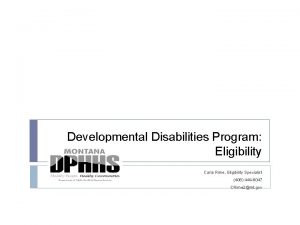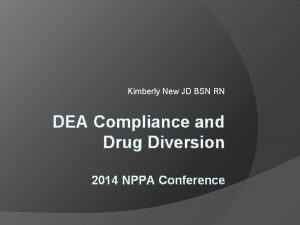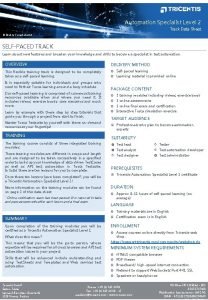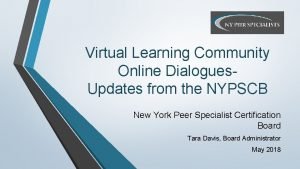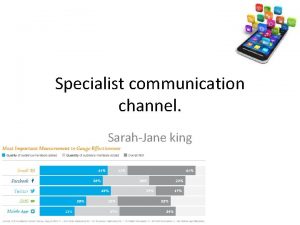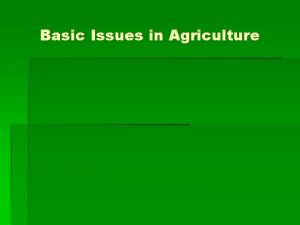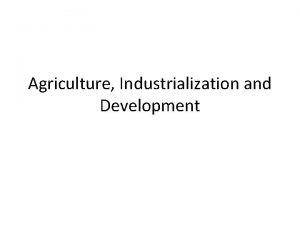Jemimah Njuki Ph D Senior Program Specialist Agriculture

































- Slides: 33


Jemimah Njuki, Ph. D Senior Program Specialist Agriculture and Food Security Prepared for the “Understanding and Addressing Youth Experiences with Violence, Exclusion and Injustice in Africa” conference 26 th June, 2019, Nairobi Kenya

Outline 1. Reflection on gender and building on progress 2. A clarification of terms and concepts 3. Gender in the research process 4. Gender in the research content • Types of gender research along the project cycle • Gender analysis domains and tools 5. Gender in monitoring and evaluation 6. Gender in dissemination and communication

Question 1: What key insights have we gained from our gender research? Question 2: What challenges do we still face?

The Guess What game

Gender Equality Entails the concept that all human beings, both men and women, are free to develop their personal abilities and make choices without the limitations set by stereotypes, rigid gender roles, or prejudices.

Gender Equity Means fairness of treatment for women and men, according to their respective needs. This may include equal treatment or treatment that is different but considered equivalent in terms of rights, benefits, obligations and opportunities.

Empowerment An expansion in people’s ability to make strategic life choices in a context where this ability was previously denied to them.

Gender Aware refers to explicit recognition of local gender differences, norms, and relations and their importance to outcomes (could be health, education, livelihoods related outcomes) in project design, implementation, and evaluation. This recognition derives from the analysis or assessment of gender differences, norms, and relations in order to address gender equity in outcomes.

Gender transformative Approaches actively strive to examine, question, and change rigid gender norms and structural imbalances of power

Gender responsive Approaches, process that strive to meet both women’s and men’s needs. These approaches ensure that both women and men will benefit, and neither will be harmed by research, programs and policy, such as, for example, by exacerbating their work burdens.

Gender Equality, Equity and Gender Justice

Gender in the research process

Gender in the project cycle 1. Project design and justification § Is there information on how the problem affects men and women, boys and girls differently? § Are these differential impacts included? § Is the evidence on these impacts stated and justified (i. e not just hypothesized but evidence is presented? ) § Are the reasons for why this is so indicated? § Is there credible evidence presented? 2. Project Objectives § Is there a specific objective to address issues highlighted in the problem statement § Are gender specifications included in other objectives where relevant? § Are these objectives clear and specific and not lost in broad terms?

Gender in the project cycle 3. Methodology and approach § Is there a clear plan and methodology for gender analysis/ § Is there a plan to incorporate the analysis into implementation plans? § Is there specific targeting of women and other interest groups? § Is gender integrated in other methodologies? § Are there clear gender research questions? § Are the gender proposed methodologies valid and grounded in gender theory and previous research? 4. Project outcomes § Are there clear gender outcomes? § Do the gender outcomes logically follow from the objectives and research methodology? § Are there gender specific indictors for tracking results? § Are proposed tools for monitoring and evaluation of outcomes valid and grounded in theory?

Gender in the project cycle 5. Budget § Are there results dedicated to the implementation of gender activities? § Is the budget adequate? (depending on activities, at least 5% of the budget? ) 6 Team § Is there gender expertise in the team? § Is the gender expertise senior enough to make decisions on what needs to be done? § Does the CV show both skills and experience? § Does the gender person seem connected to broader community of practice on gender?

Gender in the content of our research: Gender Analysis of youth and violence Different access to resources Access to spaces to get information, services Access to finance, employment and entrepreneurship opportunities Stigma, girls as brides Views about women, women as victims of violence Young men as strong Young men are perpetrators, young women are victims Participation in processes, decision making Mobility Agency to participate Who does what-roles and responsibilities Property rights Discriminatory laws e. g requirement for marriage certificates to access services Involvement in official structures e. g peace committees Policies Power over, power within, power to do, power with, Power at individual, intra-household, community, national

Norms for gender. A gender analysis includes information on women, girls and boys in terms of their division of labour, roles and responsibilities, access to, and control over, resources, and their relative condition and position in society. It also involves looking at other norms for how gender may be expressed, including norms relating to sexuality and identity. Other social variables. A gender analysis should include social variables such as ethnicity, culture, age and social class. It may also include sexual orientation. Quantitative and qualitative data. A gender analysis should include both quantitative (statistics) and qualitative data (analytical and relative). Vulnerability and empowerment. A gender analysis highlights specific vulnerabilities of women and men, girls and boys. It always has an empowerment perspective, highlighting the agency and potential for change in each group. Scope and methods vary. The scope of a gender analysis can vary and be done in different ways depending on the context.

Three different types of research Formative research (Understanding) Action research (Addressing) Evaluative research (Evaluating change) Main purpose: Understand context, Main purpose: Test models, status, current situation approaches that work to address a particular challenge Main purpose: To evaluate the outcomes or impacts of an intervention or set of interventions Main approaches: Baseline studies, Main approaches: Experimental Focus Group Discussions, Key and quasi-experimental designs informant interviews, Policy and other document reviews Main approaches: Evaluation /impact studies, qualitative case studies, econometric studies (double difference, RCTs) Main use of findings: Inform Main use of findings: Scale up project design and implementation approaches that work, inform policy Main use of findings: Inform policy, programs

Analysing and reporting gender statistics for policy and influence Some basics • • Your results need to answer 5 basic questions: What, Where, When, Why and so What? Mixed methods: Qualitative and quantitative • Differentiating between sex disaggregated data and gender statistics • Sex disaggregated data is achieved when statistics are presented for women and men throughout all tables and charts. • Doing so provides a full picture of the situation of women and facilitates comparison of information. • Gender Statistics are defined as statistics that adequately reflect differences and inequalities in the situation of women and men in all areas of life (United Nations, 2006). • Gender statistics requires the cross-tabulation of at least two statistical variables: sex and the main characteristic that is studied, such as educational attainment or labour force participation.

Analysing sex dissagrgated data and gender statistics The UN defines gender statistics as a summary of the following characteristics: 1. Data are collected and presented by sex as a primary and overall classification; 2. Data reflect gender issues; 3. Data are based on concepts and definitions that adequately reflect the diversity of women and capture all aspects of their lives; 4. Data collection methods take into account stereotypes and social and cultural factors that may induce gender bias in the data.

Example of gender blind statistics Example of not gender blind statistics

When, what and where? The basic table demonstrates the benefits on analysis from a good layout of statistics. For instance, Table 1 offers the reader the following insights: • 49, 466 girls and 58, 277 boys are enrolled in Grade 12 (absolute number). • 12 percent of all girls and 13 percent of all boys enrolled in secondary school are in Grade 10 (percent distribution). • The sex distribution among those in Grades 10, 11 and 12 is 46 percent girls and 54 percent boys (sex distribution).

Average time spent on care for children, the sick and the elderly by sex, urban/rural areas and marital status, Pakistan, 2007 (minutes per day in total population aged 10 and higher) Distribution of population by sex, age group and educational attainment, Swaziland, 2007

Analysing qualitative data 1. Content analysis. This refers to the process of categorizing verbal or behavioural data to classify, summarize and tabulate the data. 2. Narrative analysis. This method involves the reformulation of stories presented by respondents taking into account context of each case and different experiences of each respondent. In other words, narrative analysis is the revision of primary qualitative data by researcher. 3. Discourse analysis. A method of analysis of naturally occurring talk and all types of written text. 4. Framework analysis. This is more advanced method that consists of several stages such as familiarization, identifying a thematic framework, coding, charting, mapping and interpretation. 5. Grounded theory. This method of qualitative data analysis starts with an analysis of a single case to formulate a theory. Then, additional cases are examined to see if they contribute to theory.

Analysing qualitative data Broad emerging themes from qualitative research • Prioritising • Matrix Ranking Individual experiences • Presenting life histories • Quotes from individual in-depth interviews

Presenting qualitative data

Presenting qualitative data

Presenting qualitative data

From results to actions • Interpretation of gender statistics require a good grounding theories and literature on gender, women, power, masculinities etc • Key questions: • Are differences a reflection of injustice, unfairness of opportunity or outcome? • What are the underlying causes of the differences? • What results require a change in practice, a change in investment, a change in norms, a change in policy? • What is the level of change? • How can we influence that change?

Gender transformative change: What does it take? Agency: individual and collective capacities (knowledge and skills), attitudes, assets, actions, and access to services Relations: the expectations and cooperative or negotiation dynamics embedded within relationships between people in the home, market, community, and groups and organizations Structures: the informal and formal institutional rules that govern collective, individual and institutional practices, such as environment, social norms, recognition and status

Case 1: Gender transformative approaches in TVET Challenge • Low enrolment of young women in TVET • % of young women taking engineering courses low Typical Response • Increase number of ‘traditional’ courses for women i. e tailoring, catering, hair dressing

Case 1 -Contd… A gender transformative response Understanding underlying causes of low enrolment of young women • Unconscious bias, traditional perspectives of what is men and women’s work, lack of role models Changing perceptions through role modelling, transformative training for teachers and instructors, internship programs, mass campaigns https: //www. youtube. com/watch? v =oq. E 8 KMJg. AUA
 Montana developmental disabilities program
Montana developmental disabilities program Miami beach senior high school dr. maria t. rodriguez
Miami beach senior high school dr. maria t. rodriguez National agriculture imagery program
National agriculture imagery program Non specialist audience
Non specialist audience Year 11 specialist formula sheet
Year 11 specialist formula sheet Punto rojo overlay
Punto rojo overlay Prm specialist
Prm specialist Cpacc exam
Cpacc exam Do microsoft office specialist certifications expire
Do microsoft office specialist certifications expire Master training specialist certification
Master training specialist certification Norditropon
Norditropon Coating application specialist
Coating application specialist Always has a narrow niche
Always has a narrow niche Specialist species
Specialist species Arithmetic mean diameter formula
Arithmetic mean diameter formula Specialist creed
Specialist creed Offender workforce development specialist
Offender workforce development specialist Brandt wagner
Brandt wagner Specialist species
Specialist species Automation specialist level 2
Automation specialist level 2 Unit 4 common specialist technical principles answers
Unit 4 common specialist technical principles answers Kings college maths school
Kings college maths school Tablet vs smartphone
Tablet vs smartphone Boeck candy test
Boeck candy test Tobacco treatment specialist training
Tobacco treatment specialist training Ibms registration training portfolio
Ibms registration training portfolio Marvin boatright
Marvin boatright Teap job corps
Teap job corps Outline and explain two functionalist concepts 10 marks
Outline and explain two functionalist concepts 10 marks Muslim specialist hospital zaria
Muslim specialist hospital zaria Academyofpeerservices
Academyofpeerservices Specialist communication channel
Specialist communication channel Matrifen
Matrifen My dream job designer
My dream job designer
